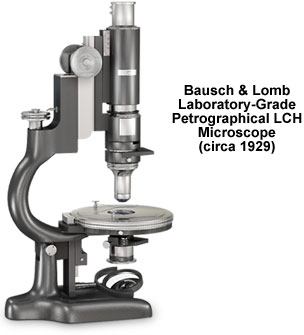Bausch & Lomb LCH Petrographical Microscope
Bausch & Lomb designers created the laboratory-grade, petrographical microscope, designated the LCH, to fulfill most of the needs of a ceramics engineer or petrographer, but not designed to meet the more rigorous demands of a research scientist during the late 1920s and early 1930s. The monocular, compound microscope, which is described and illustrated in the 1929 Bausch & Lomb catalog, proved utilitarian at identifying crystalline defects in glass and for detecting the impurities of raw materials utilized in industrial and chemical processes.

A mid-range polarized light microscope, the LCH features an analyzer box slider, which also has a slot for accessories, and that slides in and out of the body tube. The analyzer is a Glan-Thompson prism, which rotates 90 degrees. The wedges are set in a sliding prism box that is engraved with graduations and an indicator that enables withdrawal and return to the optical axis without disturbing the reading on the scale. Graduations are in 5-degree partitions, with every tenth line numbered (0, 45, 90). A lens mounted near the analyzer corrects astigmatism and helps eliminate shift of focus. The polarizer, a Nicol prism, which is set in a revolving mount, and graduated in 15-degree sectors, can rapidly be removed from the optical path via a swing-out mechanism.
The microscope features a sliding focusing tube, rather than a fixed-length body tube. Vertical movements are indicated on a vernier scale that is graduated in millimeters. The tube has a slot for a Bertrand lens, and accommodates an iris diaphragm below. Eyepieces are a standard size, for interchangeability, and each Huygenian ocular (magnifications of 7.5x, 10x, and 12.5x) is fitted with cross hairs and a focusable eye lens. Two slots in the upper edge of the body tube are designed for fixing the azimuth of the eyepiece. The interchangeable double and triple nosepieces screw into the microscope body with a standard Royal Society screw thread, and feature centering devices for adjusting the objective heads. The dry, achromatic objectives are a 10x lens system consisting of two doublets, a 45x-power lens that features significant resolving power at a numerical aperture of 0.85, and a 4x chromatic doublet, which is corrected for chromatic and spherical aberrations.
A swing-out, three-lens condenser system permits rapid switching from convergent to parallel light, and beneath the condenser, an iris diaphragm and 50-millimeter plano-concave mirror complete the illumination system. The substage is focusable by adjusting a rack and pinion mechanism, similar to the coarse focus of the American-made microscope. A modified Bausch & Lomb patented fine focus lever features a micrometer screw head graduated in 100 increments (each 2.5 micrometers in length), and a hinged vernier scale for reading to 0.5 micrometers. If the objective touches the specimen or prepared glass slide, the fine focusing adjustment ceases to operate; thus, lowering the risk of damage to the microscope optics or mounted specimen. The LCH petrographical microscope is manufactured with a revolving, circular stage, whose circumference is graduated in single degrees with each tenth line numbered. A double vernier resolves to one tenth of a degree in both directions and two 40-millimeter long scales placed perpendicular to each other are inlaid in the stage for orientation. Accessories for the mid-level petrographical microscope include a selenite plate, a quartz wedge, a quarter-wavelength plate, and a Bertrand lens. A pinhole cap that fits the drawtube of the LCH microscope allows the observation of interference figures by applying the Lasaiux method. There is also an optional mechanical stage for examining slides of rock sections.
BACK TO TWENTIETH CENTURY BAUSCH & LOMB MICROSCOPES
BACK TO TWENTIETH CENTURY MICROSCOPES
